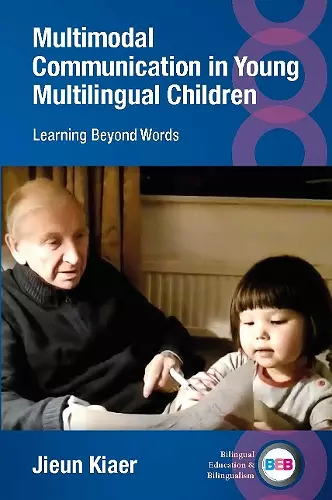Multimodal Communication in Young Multilingual Children
Learning Beyond Words
Format:Hardback
Publisher:Multilingual Matters
Published:18th Jan '23
Should be back in stock very soon

Rare focus on non-verbal behaviour and multimodal communication in bilingual children
This longitudinal study explores young children’s language acquisition in Korean-English multilingual households, investigating how children acquire multiple strategies of verbal and non-verbal communication and use a range of multimodal resources to communicate effectively with members of their family.
This book explores young children's language acquisition in multilingual households through an original longitudinal study of the author's own children and interviews with members of other Korean-English families. The study investigates how multilingual children not only acquire multiple languages (verbal communication) but also acquire multiple strategies of non-verbal communication. In the process, it is also revealed that parents learn from children, collaboratively shaping the language of their family together in a manner that is between and beyond languages and cultures. The book explores the different types and frequency of non-verbal behaviours acquired by multilingual children and reveals how multilingual families use a range of multimodal resources to communicate effectively in a way that creates solidarity. The results of this longitudinal study are discussed within the paradigm of translanguaging and provide insight into an underrepresented multilingual population. With accompanying online videos, this book offers rich multimodal family interaction data for students and researchers interested in multilingualism, family language practices, and first and second language acquisition.
This book is a valuable record of children acquiring two languages, English and Korean. Readers are given an insight into children’s language development in the context of the ecological system of communities and cultures, communicating with their parents, siblings, grandparents, nannies and peers. The author’s 'mother’s gaze' will be of great help not only to academics but also to parents who raise their children in multiple languages. * Naya Choi, Seoul National University, South Korea *
Kiaer provides an extremely rare and valuable insight into how multilingual families interact using multimodal, non-verbal expressions. The book explains why it is critical to foster more caring, nurturing and accepting translanguaging cultures at home, in schools, in our communities and throughout society. It is a must-read for teachers, scholars and teacher educators seeking ideas for cultivating translanguaging competence through ongoing co-learning among children, parents, teachers and technology. * Ju Seong Lee, The Education University of Hong Kong *
The monograph takes multilingual children’s language development research to a new level. It integrates the latest conceptual perspectives of translanguaging and multimodality and foregrounds the often forgotten role of family, emotion, sibling and culture in language learning by children growing up in a transnational family. It is written with passion and dedication. It will be a must-read for anyone interested in language development of multilingual children. * Zhu Hua, IOE, University College London, UK *
ISBN: 9781800413337
Dimensions: 234mm x 156mm x 14mm
Weight: 440g
192 pages